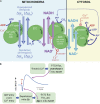Fueling thought: Management of glycolysis and oxidative phosphorylation in neuronal metabolism
- PMID: 29752396
- PMCID: PMC6028533
- DOI: 10.1083/jcb.201803152
Fueling thought: Management of glycolysis and oxidative phosphorylation in neuronal metabolism
Abstract
The brain's energy demands are remarkable both in their intensity and in their moment-to-moment dynamic range. This perspective considers the evidence for Warburg-like aerobic glycolysis during the transient metabolic response of the brain to acute activation, and it particularly addresses the cellular mechanisms that underlie this metabolic response. The temporary uncoupling between glycolysis and oxidative phosphorylation led to the proposal of an astrocyte-to-neuron lactate shuttle whereby during stimulation, lactate produced by increased glycolysis in astrocytes is taken up by neurons as their primary energy source. However, direct evidence for this idea is lacking, and evidence rather supports that neurons have the capacity to increase their own glycolysis in response to stimulation; furthermore, neurons may export rather than import lactate in response to stimulation. The possible cellular mechanisms for invoking metabolic resupply of energy in neurons are also discussed, in particular the roles of feedback signaling via adenosine diphosphate and feedforward signaling by calcium ions.
© 2018 Yellen.
Figures


References
Publication types
MeSH terms
Substances
Grants and funding
LinkOut - more resources
Full Text Sources
Other Literature Sources

